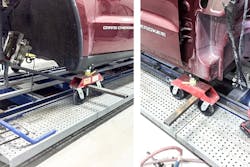THE SHOP:
The 70,000-square-foot Tom Wood Collision Center is the single collision center for 17 different dealerships in the Indianapolis area. With the large amount of work that is sent to the shop and an average monthly car count of 368, it’s essential that the shop runs as efficiently as possible.
Joe Feltman, operations manager, began his search for a new dolly because the ones that the shop used prior to the Uni-Dolly 4800 were hitting the frame racks. The frame racks at Tom Wood are in the ground with a pit surrounding them, and the shop wanted a dolly system that could move vehicles through the shop and also be versatile enough to push a car up onto the frame rack. The dollies that the shop used were too wide to do this, so the shop began searching for a replacement.
After researching different systems online and in magazines, the team settled on the Uni-Dolly system, which seemed to fit the shop’s needs. It also happened to be the 2015 SEMA Best New Product runner up. The shop purchased two to begin with to see if the product was a good fit, and now it has three. Tom Wood Collision has been using the Uni-Dolly 4800 for roughly nine months now.
HOW IT WORKS:
The mobile dolly allows for vehicles to be moved anywhere in the shop and can be used with the tires on or off. It is adjustable both vertically and horizontally allowing it to fit under any disassembled drivetrain or chassis.
The car is raised up on either a lift or a jack and then clamps (a separate purchase) are attached to the bottom of the pinch welds underneath the car. The car is then lowered and is mobile on the dolly. Only one technician is needed to operate it.
HOW IT’S USED:
Juan Blanco, master technician at Tom Wood Collision, uses the UD 4800 on a daily basis and says that it’s easy to use.
“You can stop it on a dime,” he says.
The UD 4800 has many advantages and meets almost all of Tom Wood’s needs, but there are a few issues that Blanco has run into. The design of the dolly is aimed more at compact cars, so it can’t be used on all of the vehicles that enter the shop. He also adds that adding a third wheel on the dolly might make it more stable, which is a concern he has when he raises it to its maximum height.
THE RETURN:
“It’s time savings,” Feltman says. “Now we are able to push cars to areas that would have been labor intensive before. I would say we save about a half an hour each time we put a car on a frame rack.”
Interested in knowing the impact of a particular collision repair product in the shop? Send your suggestions to [email protected].




